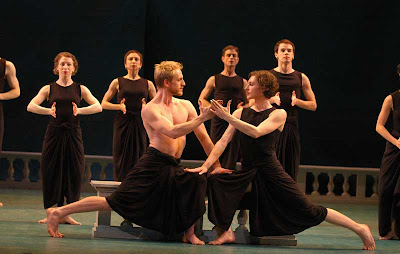
Craig Biesecker (Aeneas) and Amber Darragh (Dido), Mark Morris Dance Group, photo by Stephanie Berger |
When Mark Morris created his modern dance version of Purcell's opera Dido and Aeneas in Brussels in 1989, he cast himself in the roles of Dido and the Sorceress. With a male Aeneas and Morris's signature unisex approach to his corps of dancers, it created a gender-bending ambiguity in an interpretation with the question of gender identity and sexual desire at its core. Since retiring from the stage, Morris has tried to recreate the original production's success through recasting. In Friday night's performance at the George Mason University Center for the Arts, one of Mark Morris Dance Group's female dancers took both roles, and although the work has lost some of its magnetism it still packs quite a visual punch.
Morris is responsible for the direction and choreography of this production and also conducted the instrumental ensemble, officially under the leadership of cellist Wolfram Koessel. The disadvantage is that Morris has no musical training, although he undoubtedly knows the score very well, but the advantage is that a pair of eyes that knows the choreography inside out is setting the musical pace. Musically, this was not a superlative evening, at least by the standards of the best historically informed performance ensembles (see my review of recordings). The singers, while generally good, were amplified, and the strings had a few clumsy moments, especially early in the evening. The strongest voice was Jamie Van Eyck, a promising young mezzo-soprano last reviewed here in the Tanglewood performance of Elliott Carter's What Next?. Her Dido and Sorceress were sinewy and vital, more muscular than burnished. The George Mason University Singers, taking advantage of a remarkable performing opportunity, sang with unity and accuracy, bunched together at one end of the orchestra pit. One of their own, Adam Rothschild, was even selected to sing a brief solo as a sailor.
While one might have wished instead for the accompaniment of Tafelmusik and a starrier vocal cast (as on the group's DVD release of this production, available through their Web site), the music is only one part of the aesthetic pleasure afforded by this work and it is certainly better to have a good live performance than an excellent recorded one. The set design by Robert Bordo is austere, a fence-like barrier at the back of the stage, which is covered by a turquoise curtain that obscures a shining light (lighting by James F. Ingalls). Stepping into Morris's shoes, Amber Darragh is distinguished from the corps only by her silvery fingernails. She cut an aquiline and strong-shouldered profile, convincingly androgynous at times. The unisex black shirts (costumes by Christine Van Loon) obscure the differences between male and female dancers, with the only exception being Craig Biesecker's bare-chested Aeneas.
Morris's choreography is stitched closely to the music, with runs in the vocal line, for example, paired with frantic hand movements, or an evenly running basso continuo (as in the Second Woman's Oft she visits this lone mountain) set to the corps's rapidly shuffling feet. The vocabulary could be described as one part vaguely traditional, another part show choir kitsch, and another strikingly unconventional. The sorceress's first appearance, with Darragh writhing on a small bed, was one of the most memorable moments, and that image finds its echo when Darragh's Dido collapses, dead, at the end. The sense of the visual activation of the music's rhythmic vitality, even if it is not authentic Baroque dance, is one of the things that makes this version so captivating. So much of Baroque music is made for dancing and without that component of organized movement, it loses a part of its meaning.
As for the postmodern subtext layered under the libretto by Nahum Tate, the opera was created for a girl's school in Chelsea, where its condemnation of the dangers of love may have been construed as a message to the "young gentlewomen" of the school. Dido and Aeneas's love is destroyed, not by the gods as in Virgil, but by the sorceress and her witches, presented here, justifiably in terms of the 17th-century ballet's sense of evil, in a somewhat burlesque way. Morris's twist is that Dido is, in a sense, betrayed by her own self-hatred, since the sorceress is her double, a spiteful Doppelgänger hungry to bring down anyone "in prosp'rous state." When the witches watch the sailors readying to depart, they celebrate their victory with a dumbshow about romantic love. Turn by turn, a pair of lovers rises up from the corps, finding one another, embracing, and then one violently killing the other. Each murder in the sequence causes the sorceress to clap in delight, until she finally collapses in orgasmic ecstasy. Happy Valentine's Day to you, too, Mark Morris.
The remaining performance of Mark Morris Dance Group's Dido and Aeneas is tonight (February 16, 8 pm), with a male lead dancer, Bradon McDonald, as Dido and the Sorceress.























































3 comments:
Dear Mr. Downey -
As one of the singers in the Mark Morris production of Dido which you have reviewed here, I would like to point out that while we had microphones in front of us, we were not miked for the house, but only for the stage monitors (for the dancers). I hope that it did not sound amplified in the house, as that would be unfortunate.
All my best -
Yulia Van Doren
Great review, Charles!
as for the DVD... the company sells it on their web site for $25.
Thanks for that tip, anonymous, which I have noted in the review.
Ms. Van Doren, thank you for the comment. I should have noted that the amplification may have been for the dancers on the stage. Thanks for pointing it out. Yes, unfortunately, the amplified sound was present in the house. I am glad to know that was not what was intended.
Post a Comment